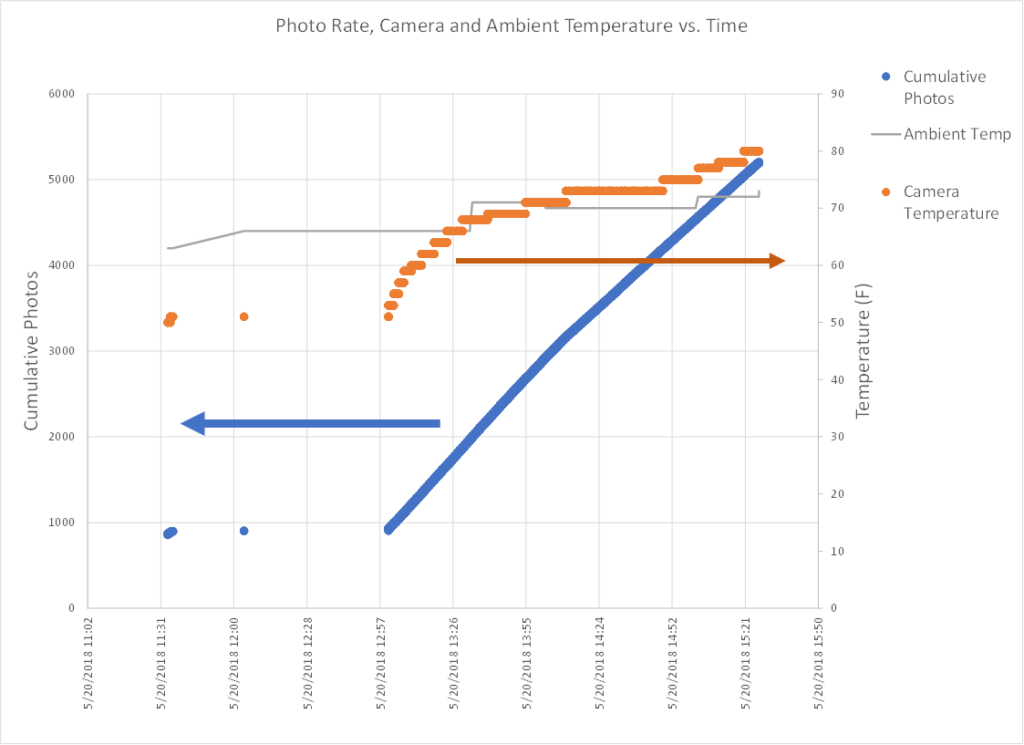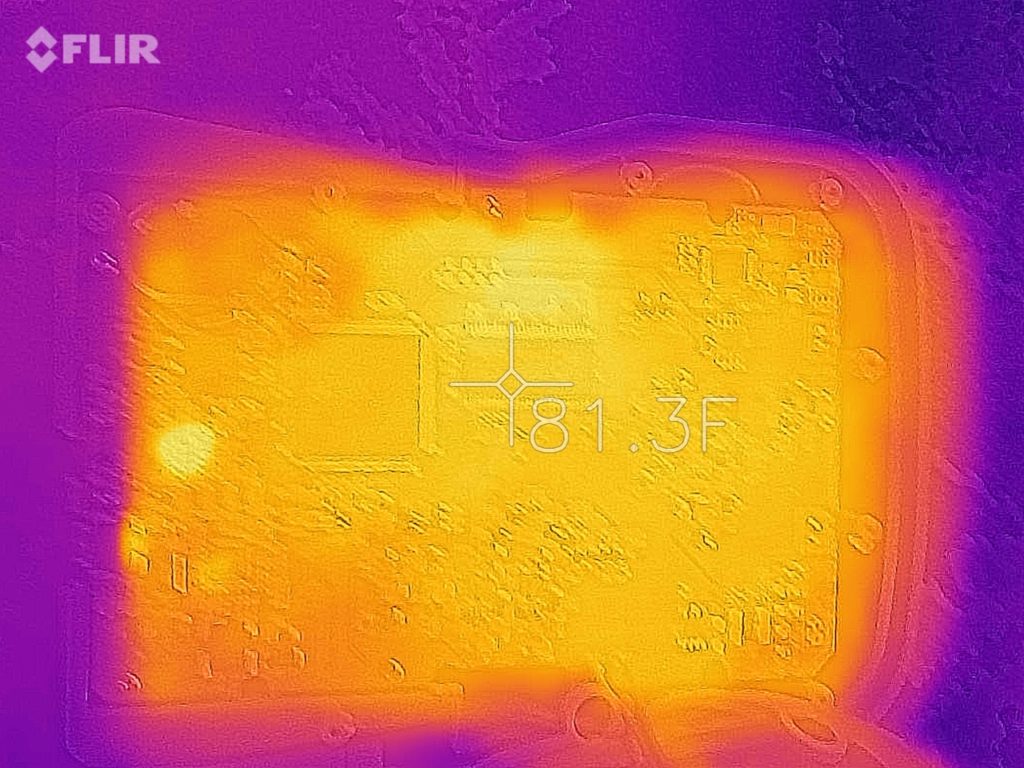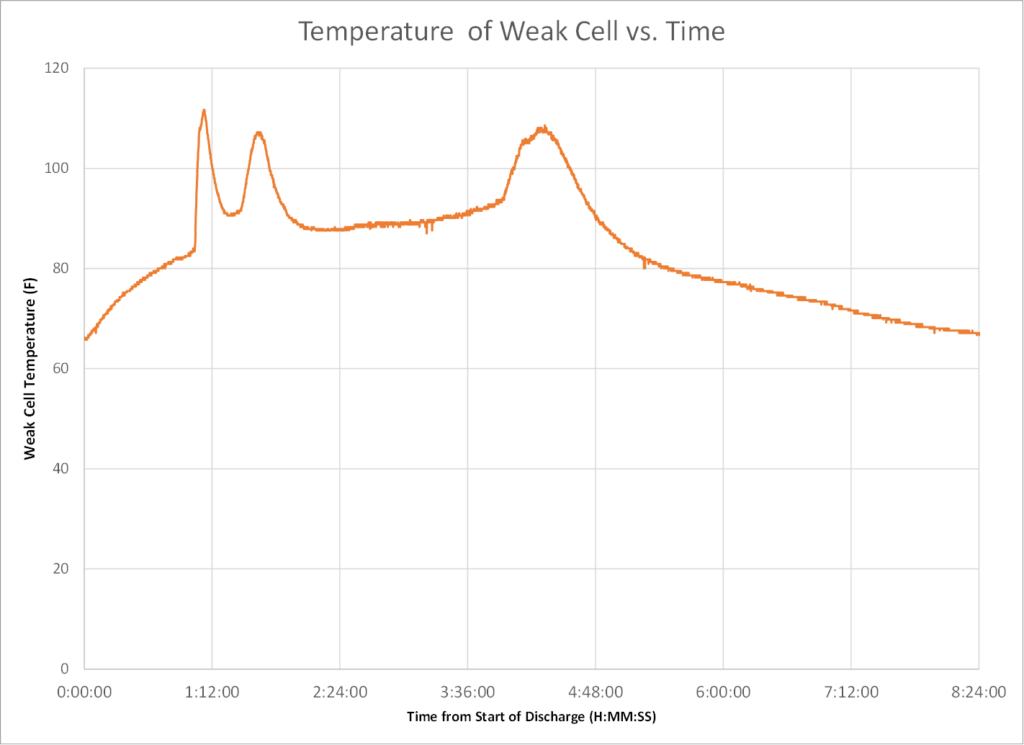Runaway Trail Cameras
When we picked up trail cameras from the desert southwest, Janet and I found several runaway trail cameras. These cameras continuously took photos until the SD card filled, or the batteries expired. Runaway events were distinct from “false trigger” events that occur due to waving vegetation. They often took place at night, and were characterized by triggers one right after another at the maximum rate of the camera. Others have reported this frustrating phenomena, and it seems to afflict cameras from multiple vendors and in multiple settings. In this post, I propose a cause for (at least some) runaway events, show the results of some experimentation to test my hypothesis, and offer some easy steps to avoid runaway trail cameras that have worked for us.
Data From Runaway Trail Cameras
Fortunately (or not), we had a number of runaways, so I had access to a lot of data. I created a graph of the cumulative number of photos taken vs. time shown below. Each line is from a different camera. Note that most show discrete “steps” of 100’s to 1000’s of photos taken in a very short time interval. These are the runaways.

Looking at these graphs, and the photos taken during the runaway events, I noticed several things about the runaway events:
- the signature was distinct, characterized by continuous taking of photos with no apparent activity or motion in the photo
- sometimes the runaway was complete — that is, the camera kept taking photos continuously until it ran out of file space or batteries, but sometimes the camera seemed to recover
- runaway cameras also tended to have higher “false triggers” due to waving vegetation, as indicated by lines with larger slopes in the graph. In contrast, cameras with low false trigger rates (the flattest lines, at the bottom of the graph) did not run away, either
- sometimes, different cameras, in different locations, experienced runaway events on the same date, even at the same time
- took place at day or night
- happened at different temperatures, but during runaway event, the temperature recorded on the info strip, recorded at the bottom of each photograph, rose substantially, sometimes by as much as 40F
- seemed to be associated with large burst counts — in this case 9 photos per trigger — which we used for the first time for these cameras.
Hypothesis: Internal Heat
I ruled out camera failure because these same cameras worked well before and after these events. I hypothesized that somehow the PIR sensor was continuously triggering, despite the absence of a target in the field of view. Since PIR sensors detect changes in temperature, the rise in temperature recorded in photo strips during these events seemed worth investigating further.
I made another chart — this showing the temperature recorded by the camera in the info strip during one of the runaway events, along with the cumulative photos, and the “local” temperature (as reported by the national weather service for the general area).

This graph shows that the camera started taking photos at 12:57 on May 20, 2018. It continued for more than 2 hours — accumulating over 4000 photos. The pattern in camera temperature is consistent with a high temperature heat source inside the camera. The fast rise in temperature suggests the heat source appears suddenly; and the tapering off of temperature suggests that this heat source itself reached a maximum temperature greater than 80F. The camera temperature rose 30F above the initial temperature of the camera. The weather could not be blamed, as the ambient temperature in the area rose less than 10F during the event.
Runaway Scenario
The pieces were coming together. A heat source inside the camera causing a sudden rise in temperature seemed like it might trigger the PIR sensor itself. The likely heat source is ultimately from the energy stored in the batteries. This energy is either dissipated as heat by camera circuitry, or perhaps by the batteries themselves. This could lead to a runaway event: once triggered, the camera would generate heat at some rate high enough to trigger the PIR sensor; which would cause the camera to take more pictures; which would cause more heat; and so on, in a run away event.
Possible Culprit — the camera itself?
The electronics in the camera certainly generate heat. Taking a burst of (high resolution) photos consumes a relatively large amount of power; as does powering the IR flash for night-time photos. See photo below of the camera circuit board in the lab taken with a thermal camera while the trail camera itself was taking pictures. The overall temperature of 81.3F is only 10F above the ambient room temperature, suggesting that this was not the heat source we observed in the run away events in the field. This was consistent with my expectations, since if the camera electronics were the problem, I would expect to see the runaway problem happen even more often.

Experiment: Mismatched Batteries
We had put all new Lithium Iron Disulfide (Energizer Ultimate Lithium AA) batteries into each camera. What if one of these batteries had a lower charge than the other 7? To test this out, I:
- chose 7 new batteries, and 1 mostly discharged battery and put them into the 8 battery cartridge from a trail camera.
- attached a thermo-couple (electronic thermometer) to the partially discharged battery and recorded its temperature over time
- connected the battery cartridge to an electrical load similar to that of a the camera taking a burst of photos at night.
Below is a graph of the temperature I measured vs. time. This data shows that as the charge in the older battery is exhausted, it begins to heat up, as the remaining good batteries do their best to push an electric current through all 8 batteries to the load. The spikes in temperature are intense and dramatic, reaching temperatures in excess of 100F in a matter of minutes, and maintaining this for several minutes, in multiple events. There is a thermal cutoff device inside the battery that I believe limits the temperature, and causes it to drop back down after it peaks. See references below for technical specifics of the batteries in question.

Loose Ends
This result is supportive of my hypothesis, but not a complete proof. I had shown that an unmatched battery could heat up inside the battery cartridge, but I had not shown that such heating would, in turn, trigger the PIR sensor, which would complete the cycle necessary for continuous triggering. Nor had I shown that a new package of batteries might contain at least one weak cell.
I installed a heater inside the battery cartridge, and tried to use it to trigger the camera. The heater was under-powered, and I confess that I was distracted by other things before I was able to cause the PIR sensor to trigger from the inside.
I also sacrificed several new packages of batteries to see if there were any weak cells inside. I measured the discharge of each one to see if any were significantly weaker than the rest. Here again, results were negative for the small sample I chose. This is actually good news, and suggests that if weak cells occasionally turn up in new packages, it doesn’t happen very often. The fact that this happened to multiple cameras in a single outing suggests that we might have run into a bad batch from the manufacturer.
Discussion and Conclusion
The circumstantial eveidence seems compelling: we know that if there is an unmatched cell in the group of 8 in the camera, it will heat up dramatically — to temperatures above 100F — under loads typical for the camera; we know that PIR sensors are sensitive to temperatures in the range of 100F; and we know that something hotter than the electronics themselves was heating up the camera as recorded on the info strip of photos taken during the runaway events. Given this, I feel pretty comfortable concluding that mismatched batteries are at least one source of runaway trail cameras.
Avoiding the Runaway
Based on this conclusion, here are two steps we’ve taken to avoid runaway caused by overheating of mismatched batteries:
- Use new, or at least well matched batteries. It goes without saying that all the the batteries for a given trail camera should be same type — i.e. don’t mix alkaline and Lithium cells. Cells right out of the package are likely to be fully charged (in our experience), though no manufacturing process is perfect. When using older batteries, we use a multi-load tester to match partially discharged batteries as much as possible. Stay tuned for a post on the testing of primary Lithium batteries, including results on the accuracy of multi-load testers.
- Set the camera to take a rest between triggers, especially when setting the camera for large burst counts. Many cameras have this feature, often (confusingly) labeled, “trigger delay.” Having the camera sit idle after for as little as a a minute between bursts allows any unmatched battery to cool down, thereby breaking the runaway cycle.
Have you experienced cases of runaway triggers in your trail cameras? Does a diagnosis of unmatched battery apply? Or are there other circumstances? Please reply in comments below.
References:
Energizer Ultimate Lithium Battery Handbook and Application Manual

This is really interesting and helpful, Janet. I’m wondering how or whether runaway events are related to an issue of cameras that exhaust one or two batteries, while the others are still have a strong charge. Sometimes those cameras have runaway events, and sometimes not.
But why would a camera drain one or two batteries, leaving the others high-charged? And why would this happen whether all the batteries were from the same new pack?
Because of this issue, I’ve been in the habit of checking strength of all the batteries in a camera, discarding the drained ones, replacing the strong ones, and adding new, well-charged batteries as-needed. Based on this test, I should make sure all of the batteries are at the same relative strength. Still not sure why a camera would deplete one or two batteries.
Thanks – Eric
Most of the commercial trail cams we use have an 8-AA Battery cartridge in which the cells are connected in series — that is, in a chain from a “minus” terminal on the cartridge, through each battery in turn, to a “plus” terminal for the cartridge. The amount of current through the chain is the same for all the batteries (just as the water flow in a hose is the same at any point along the hose). Charged batteries have the same voltage (~1.5/1.6 Volts), thus the power (voltage * current) is the same for all of the batteries. So I don’t think your any particular battery cell is supplying more than it’s share of power (or energy, over time). I think the way one ends up dead before the others is that it starts out with less charge in the first place, and therefore runs out before the rest. I am not aware of any battery tester that can accurately measure the state of charge for a Lithium Iron Disulfide (Energizer Ultimate Lithium) battery — and I have looked. I plan a future post on this topic including alot of discharge data from many “not new” batteries.
On the plus side, if you have a setup that routinely generates runaways, this is a great opportunity for an experiment! You can try a solution which has been suggested by others providing feedback to my blog post: you can use an external battery pack (likely available for your camera), plugged into the “aux power” socket. If your setup is experiencing a runaway thermal event, the external battery pack will fix it — since the PIR sensor should be far enough away from the external battery not to trigger. If you still get runaways with an external battery, we need another theory 🙂
Because you are talking about cameras with 8 batteries I would think most likely they would be commercially purchased trail cameras and not Homebrew DSLR’s you testing.
It’s difficult to say what sensor these cameras are using. Operating ranges of DC power on the sensors I have looking at range from 2-6vdc. 8 battery camera would have an input voltage of around 12 to start with and as the batteries voltage dropped might be down to 9 or 10vdc when the camera reports them at 0% power remaining. I would like to know what this voltage setting for 0% remaining is, any idea? Have never tested it. This is some data I would like to see made available in the picture file data along with the file date and time, “Battery remaining”
So somewhere on the board there must be a voltage regulator to set the voltage correctly for the sensor. If this were to drift voltage may fall below the minimum voltage especially during high usage triggers like when the LEDs are being driven.
Also it takes some time for the sensor to stabilize once voltage is applied. Some data sheets I have looked at say up to 45 seconds. (Wonder if this is the real reason why cameras have countdown timers when you turn them on?) During this time the sensors are prone to false trigger. So what may be happening is that the voltage regulator is drifting outside of the operating range of the sensor during swings in temperature. These input voltage fluctuations causing the sensor to restart and during this wakeup time triggering the camera to take photos, again, over and over.
Just a WAG at what might be happening.
The voltage at which the “battery meter” reads 0% varies a little by camera manufacturer, but is somewhere around 8 volts (1 volt per cell) for the Exodus and Browning cameras I’ve looked at.
Agree that there is a voltage regulator for the sensor — likely independent of the voltage regular for the camera and microprocessor. The sensor voltage regular wants to be very efficient at very low power consumption; whereas the camera/microprocessor need a regulator that is efficient at higher power levels. Easiest to accomplish this with two regulators.
Agree re: required startup idle time for PIR sensor, during which time, it can’t be trusted. I think the firmware in the camera enforces this idle time (ignores the sensor input until power has been applied for some time). My guess is that if the battery voltage is too low to support the PIR sensor, it is first too low to support the (higher power) microprocessor. The dynamics of this hardware software system as the batteries die could certainly get complicated — with sensor computer and sensor cutting out, then rebooting. I never suspected that a battery pack could be so rich in possible behavior!
I read this with interest, as I’ve had substantial frustration with this issue on a few cams, mainly Browning’s Advantage. I reluctantly solved the problem by delegating them to cool dark sites, where they seemed to NOT have any problem. After reading, I wished I tried running the cams on remote power pack, as I never considered the rise in internal temp as a possible cause. I shoot exclusively video clips so that adds another variable to the confusion…BUT,..My preferred settings are 10 length, with as short a delay as possible. Come to think of it, I do think I remember a Browning tech. suggest using a much longer delay, but this would greatly diminish the utility of the unit.
My observations vary somewhat from the Writer’s in that the run-on exposures happened mostly during the warmest / brightest hours of the day… like 10am.-4pm….even on overcast, perfectly calm days. I almost never had a problem at night. ( even in Summer, night are cool here ) The “series” seemed to be started by a legitimate trigger. The MOST problematic setting seemed to be large overview sites, eg. a field from a high perspective. Thanks for all the research work, and sharing. Several of My favorite cameras would be a lot more versatile if I could get a handle on eliminating the run-on issue.
Thanks for sharing your experience — Janet also likes the “long burst, short recovery time” setting. If you end up trying a remote battery pack, I’m interested in the result. It does create a more complicated set, and with it the opportunity to get one more thing not get quite right 🙁
Great info! thanks for sharing
I’ve had Energize Ultimate Lithium batteries that seemed bad right out of the package. They lasted less than a month in a commercial trail camera (Bushnell), so I checked the voltage of each individual battery — six were around 1.2, but the other two were at 0.8 volts. A second package of eight purchased at the same store did the same in a Browning camera with roughly the same voltage result. I now check each package of batteries before putting them in a camera.
With my homebrews when the batteries powering the control board have markedly dropped in voltage the boards trigger the camera repeatedly until the memory cards are full.
Very interesting. Since you started checking batteries before putting them into the camera, have you found any that are at a lower voltage right out of the package? While checking new batteries at one point, I did find a couple of cells which my tester called out as “partially charged” (based on two voltage measurements). I subsequently discharged these to a known load while recording voltage in the lab. Although they were lower voltage than the other new ones in the package, the discharge test showed they exceeded the specified capacity. Thus, I do not have a “smoking gun” — a battery from a new package that I have tested under controlled conditions, which failed to meet capacity specification.
For homebrews, which control board are you using?
The two packs of Energizers that apparently had two bad cells each were bought at a chain home improvement store at the same time. Since then I’ve purchased the lithiums at a neighborhood hardware store and a supermarket and they’ve all been fine, lasting about six months in my commercial trail cameras. Most of my Browning cameras are run on rechargable batteries, but I use lithiums in the winter; my Bushnells won’t run on rechargables so they always have lithiums.
I’ve built homebrews using Bigfoot, Snapshot Sniper II, CritterGetter, Safari and GameWatcher boards and they all behave the same way when the board batteries’ voltage drops significantly. All those boards are powered with rechargable AAA or rechargable 9v batteries; I rewired the SS II boards to run on three AAAs.
Thanks, Woody for the info. I’m glad that you have been having success with most recent batches of lithiums. I will keep an eye out on our home-brew front. We have used the SSII with it’s own “mini” Lithium cell with success. Have not seen this problem — possibly because have not had that cell wear out recently (we don’t have nearly as many camera-hours on the HBs as on the commercial Trail Cams).
Pingback:Are My New Batteries Really New? - Winterberry Wildlife
Pingback:How (some) Trail Cameras Fail - Winterberry Wildlife